
Piggott is a city in Clay County, Arkansas, United States. It is one of the two county seats of Clay County, along with Corning. It is the northern terminus of the Arkansas segment of the Crowley's Ridge Parkway, a National Scenic Byway. As of the 2010 census, Piggott's population was 3,849. The town was named after James A. Piggott, one of the early settlers and initiator of the local post office.

The U.S. Post Office in San Pedro, California, is a historic Streamline Moderne post office built in 1936. Designed by supervising architect Louis A. Simon with architects Gordon Kaufmann and W. Horace Austin, the San Pedro Post Office was listed in the National Register of Historic Places in 1985. The building also formerly served as a U.S. Customs Office. The building's use of marble, bronze and milk glass are typical of 1930s architecture for U.S. government buildings. The floor tile is laid in a basketweave pattern surrounded by black marble, giving the effect of rugs on a marble floor. Some of the original bronze lamps and ink wells are still intact at the public writing desks. The Section of Painting and Sculpture commissioned Fletcher Martin to create the post office mural, titled Mail Transportation (1938).

The main U.S. Post Office in New Rochelle is located at 255 North Avenue, at the intersection of North Avenue and Huguenot St., in the city of New Rochelle in Westchester County, New York. The facility currently serves the 10801, 10803 and 10805 ZIP Codes, covering portions of New Rochelle and neighboring Pelham and Pelham Manor.
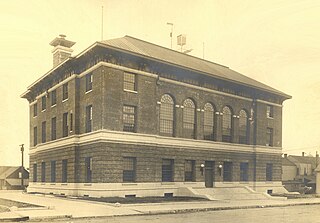
The United States Post Office and Courthouse in Eureka, California is a courthouse of the United States District Court for the Northern District of California. Completed in 1910, this historic building was listed on the National Register of Historic Places in 1983. Its architecture, designed by James Knox Taylor, is mixed, reflecting several styles. It initially served as a customhouse, in addition to being a courthouse and post office.

United States post office murals are notable examples of New Deal art produced during the years 1934–1943.

El Viejo Post Office is a historic post office in downtown Modesto. Built in 1933, the post office houses murals depicting pastoral scenes. The building's roof is made entirely of terra cotta tiles.
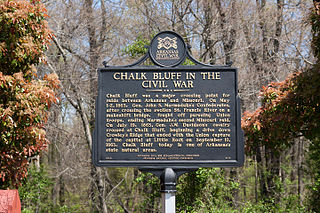
Chalk Bluff was an unincorporated community in Clay County, Arkansas, United States, approximately two miles (3 km) northwest of St. Francis. The town was formed in the 1820s at the point where the St. Francis River cuts through Crowley's Ridge from west to east. The name of the community was derived from the white clay bluff created by this crossing. The founder of the community was Abraham Seitz, who established and operated a ferry crossing and general store in the area from the 1830 until it was destroyed during the Civil War. The community occupied a strategic location and was often referred to in the reports of Union and Confederate forces vying for control of Northeast Arkansas during the war. Several skirmishes occurred near the ferry crossing, one of which was significant it enough to become known as the Battle of Chalk Bluff, which took place in early May 1863. The town was abandoned following the Civil War and most residents moved to the new railroad town, St. Francis, Arkansas. The location was listed on the National Register of Historic Places in 1974.

US Post Office-Manitou Springs Main or Manitou Springs Post Office is a historic building located on Canon Avenue in Manitou Springs, Colorado. It is on the National Register of Historic Places.
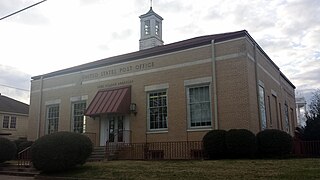
The Lake Village Post Office is a historic post office at 206 South Cokley Street in Lake Village, Arkansas. The single-story brick Colonial Revival building was built c. 1939; it is roughly square in shape, with a four-sided cupola topped by a bell-cast roof and pyramid. The interior features a mural drawn by Avery Johnson and installed in 1941; it was financed by the Treasury Department's Section of Fine Arts, and depicts cypress trees and deer.
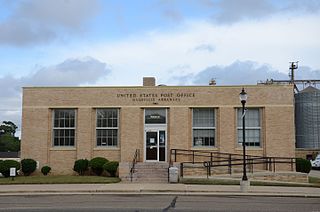
The Nashville Post Office is a historic post office building located at 220 North Main Street in Nashville, Howard County, Arkansas.

The DeWitt Post Office is a historic post office at 221 West Cross Street, DeWitt, Arkansas. It is a modest single-story brick and masonry structure with a hip roof, built in 1939 in a restrained Colonial Revival style. It is a basically rectangular structure, with a loading dock area projecting from the center of the rear. The building is notable for the murals in its lobby area, painted by William Traher of Denver, Colorado, and paid for with funds from the United States Treasury Department's Section of Fine Arts, a Depression-era project to support artists.
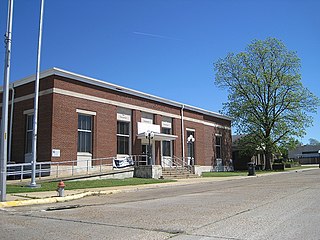
The Wynne Post Office is located at 402 East Merriman Street in Wynne, Arkansas. It is a single-story brick structure, with a built-up parapet obscuring a flat roof. A recent addition extends to the rear. The building was built in 1936 at a cost to the federal government of $65,000. It is most notable for the mural that adorns its main lobby, titled Cotton Pickers, which was created by Ethel Magafan with funding from the United States Treasury Department's Section of Art, a Depression-era jobs program for artists.
The Piggott Commercial Historic District encompasses the original center of the city of Piggott, Arkansas, as originally platted out in 1887. It is centered on the square where the Clay County courthouse is located, buildings facing the courthouse square, and also buildings along some of the adjacent streets. In addition to the courthouse, the district includes the c. 1910 railroad depot, city hall, two churches, the 1930s Post Office building, a cotton gin, and a grain storage yard. The town grew because of the railroad, and the plentiful timber in the area, whose harvesting fueled the early economy in the region. The oldest building in the district is the 1897 Clay County Bank at 188 West Main Street.

The Old Pocahontas Post Office is located at 109 Van Bibber Street in downtown Pocahontas, Arkansas. It is a single-story square brick building with a flat roof highlighted by a concrete cornice. It was built in 1936–37 with funding from the Works Progress Administration, and is a local example of restrained Art Deco architecture. Its main lobby housed a mural funded by the Section of Fine Arts, drawn by H. Louis Freund, entitled Early Days of Pocahontas.
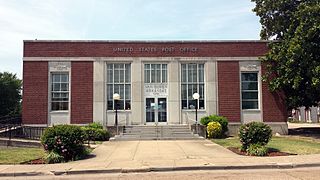
The Van Buren Post Office is located at 22 South 7th Street in Van Buren, Arkansas. It is a single-story brick and stone building, with restrained Art Deco styling. The main entrance is topped by a panel with aluminum signage identifying the building, with a large window above. It is flanked by tall pilasters, beyond which are tall windows and another pair of pilasters. The outer bays of the facade, set off from the center, have windows topped by decorative Art Deco panels. The post office was built in 1936, and features a mural by E. Martin Hennings, that was executed in 1940 with funding from the Treasury Department's Section of Fine Arts.
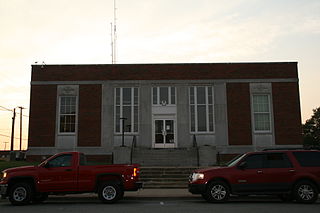
The former Morrilton Post Office is a historic post office building at 117 North Division Street in downtown Morrilton, Arkansas. It is a single-story masonry structure, built of brick and limestone in a simplified Art Deco style. Its facade is divided into five bays, the outer two separated by brick piers from the inner three. The inner three are articulated by limestone pilasters, and feature large multipane windows and the main entrance. The interior features a mural entitled Men at Rest by Richard Sargent, painted in the 1930s as part of a federal works project.

The Dardanelle Post Office, originally the Dardanelle Agriculture and Post Office, is a historic government building at 103 North Front Street in downtown Dardanelle, Arkansas. It is a single-story brick building, with a hip roof. It has a five-bay front facade, with a center entrance flanked by pilasters and topped by a panel, transom window, and dentillated entablature. Built in 1937, it has modest Colonial Revival style, and is most notable for the mural in the lobby, painted in 1939 by Ludwig Mactarian, and entitled Cotton Growing, Manufacture and Export.
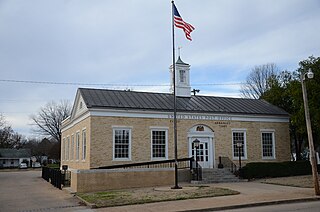
The Paris Post Office is located at 206 North Elm Street in downtown Paris, Arkansas. It is located in a modest Colonial Revival building, built in 1937 as part of a major federal building project. It is notable for the controversy over its interior artwork, which was funded by the Treasury Department's Section of Fine Arts, and executed by Joseph P. Vorst. The murals proposed by Vorst depicted a raggedly dressed African-American with several skinny mules, approaching a tarpaper shack that appears to be the man's home. There was public outcry, with Vorst defending the depiction as an accurate rendition of the area during a visit he made. He then submitted an alternate drawing, which showed a stock farm, cotton gin, and other more benign imagery, which was accepted.
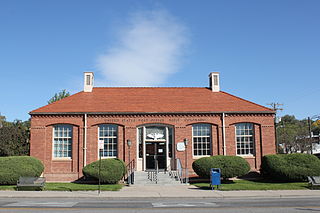
The Rifle Main Post Office, at Railroad Avenue and Fourth Street in Rifle, Colorado, United States, was built in 1940. It includes a New Deal mural. It was listed on the National Register of Historic Places in 1986.




















